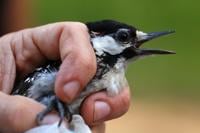WASHINGTON (AP) — The red-cockaded woodpecker, an iconic bird in southeastern forests, has recovered enough of its population to be downlisted from an endangered species to a threatened one, the U.S. Fish and Wildlife Service announced Thursday.
"The downlisting of the red-cockaded woodpecker marks a significant milestone in our nation’s commitment to preserving biodiversity,” said Interior Secretary Deb Haaland in a statement.
At one point in the 1970s, the red-cockaded woodpecker population had dipped as low as 1,470 clusters — or groups of nests, wildlife officials said. Today, there are an estimated 7,800 clusters.
“It’s an amazing bird that has an unusual communal nesting structure,” said Will Harlan of the nonprofit Center for Biological Diversity. “All nests usually cluster in the same tree, and the birds stick together as a family unit.”
Red-cockaded woodpeckers are habitat specialists that nest only in mature long-leaf pine forests, building nests in cavities of living trees partially hollowed out by a fungus.
Long-leaf pine forests once spanned much of the Atlantic and Gulf coastal regions, from New Jersey to Texas, but logging and development in the region reduced that to only 3% of this original habitat today, said Harlan.
Red-cockaded woodpeckers were one of the first species designated as “endangered” in the United States in 1970, and the birds received full protections with passage of the Endangered Species Act of 1973.
Since then, habitat restoration and protection on both public and private lands have helped the species to partially recover. Managed efforts to relocate birds from stronghold areas to reestablish populations in other forests have also aided the species, said Georgetown ecologist Emily Williams.
“The news is exciting because it’s a conservation success story in many ways," she said. “But there still needs to be caution to keep the species thriving."
It will still be prohibited to “take” — meaning harass, hunt or harm — the woodpeckers or their habitat in most instances. But the status change allows for the possibility of some new exceptions to those protections.
“The species still has a long way to go for a full recovery,” said Ramona McGee, senior attorney and wildlife program leader at the Southern Environmental Law Center. “Removing endangered species protections now could reverse past gains."
—-
The Associated Press Health and Science Department receives support from the Howard Hughes Medical Institute’s Science and Educational Media Group. The AP is solely responsible for all content.












































